《跨文化交际》主要内容梳理共26页
跨文化交际全书总结
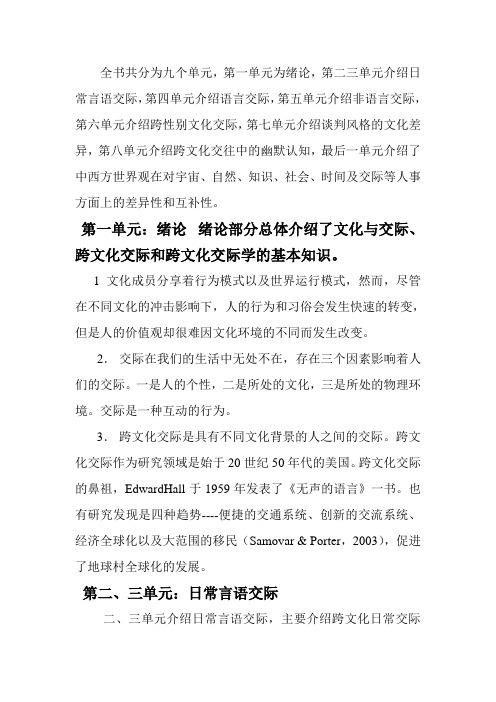
全书共分为九个单元,第一单元为绪论,第二三单元介绍日常言语交际,第四单元介绍语言交际,第五单元介绍非语言交际,第六单元介绍跨性别文化交际,第七单元介绍谈判风格的文化差异,第八单元介绍跨文化交往中的幽默认知,最后一单元介绍了中西方世界观在对宇宙、自然、知识、社会、时间及交际等人事方面上的差异性和互补性。
第一单元:绪论绪论部分总体介绍了文化与交际、跨文化交际和跨文化交际学的基本知识。
1文化成员分享着行为模式以及世界运行模式,然而,尽管在不同文化的冲击影响下,人的行为和习俗会发生快速的转变,但是人的价值观却很难因文化环境的不同而发生改变。
2.交际在我们的生活中无处不在,存在三个因素影响着人们的交际。
一是人的个性,二是所处的文化,三是所处的物理环境。
交际是一种互动的行为。
3.跨文化交际是具有不同文化背景的人之间的交际。
跨文化交际作为研究领域是始于20世纪50年代的美国。
跨文化交际的鼻祖,EdwardHall于1959年发表了《无声的语言》一书。
也有研究发现是四种趋势----便捷的交通系统、创新的交流系统、经济全球化以及大范围的移民(Samovar & Porter,2003),促进了地球村全球化的发展。
第二、三单元:日常言语交际二、三单元介绍日常言语交际,主要介绍跨文化日常交际中经常出现的问题,如称呼、话题选择、拜访礼仪、赞语与赞语应答等。
1.称呼。
中西称谓语分为两种,一是亲属称谓,一是社交称谓。
由于中西方文化背景不同,无论亲属称谓还是社交称谓都存在很大的差异。
汉语亲属称谓系统繁杂多样,而英语亲属称谓则相对贫乏,指称宽泛,语义模糊,比如一个Cousin就相当于汉语的“堂兄弟姐妹,表兄弟姐妹”等八个词。
中英语在社交类称谓方面差异也较显著,汉语的身份类称谓种类多,范围广,尤其表现在头衔性称谓的偏好,英语身份类称谓种类少。
中文中身份类称谓可细分为三种:(1)姓+职务;(2)姓+职称;(3)姓+职业。
类似王院长、李教授、肖律师等称谓在生活中屡见不鲜。
跨文化交际知识点汇总
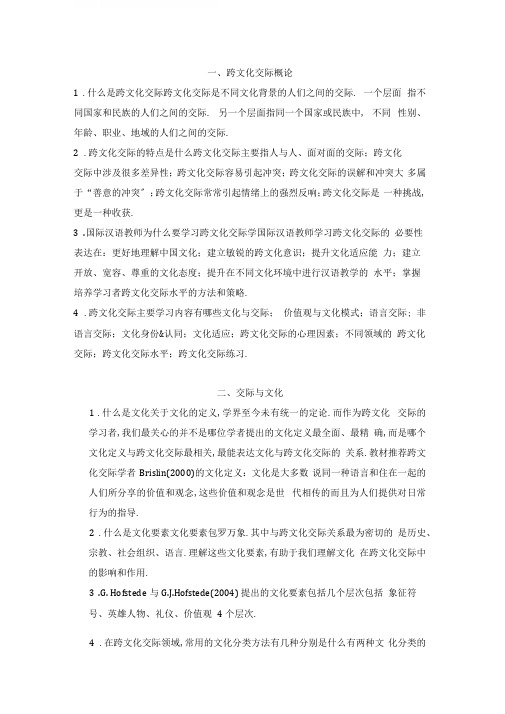
一、跨文化交际概论1.什么是跨文化交际跨文化交际是不同文化背景的人们之间的交际. 一个层面指不同国家和民族的人们之间的交际. 另一个层面指同一个国家或民族中, 不同性别、年龄、职业、地域的人们之间的交际.2.跨文化交际的特点是什么跨文化交际主要指人与人、面对面的交际;跨文化交际中涉及很多差异性;跨文化交际容易引起冲突;跨文化交际的误解和冲突大多属于“善意的冲突〞;跨文化交际常常引起情绪上的强烈反响;跨文化交际是一种挑战,更是一种收获.3.国际汉语教师为什么要学习跨文化交际学国际汉语教师学习跨文化交际的必要性表达在:更好地理解中国文化;建立敏锐的跨文化意识;提升文化适应能力;建立开放、宽容、尊重的文化态度;提升在不同文化环境中进行汉语教学的水平;掌握培养学习者跨文化交际水平的方法和策略.4.跨文化交际主要学习内容有哪些文化与交际;价值观与文化模式;语言交际; 非语言交际;文化身份&认同;文化适应;跨文化交际的心理因素;不同领域的跨文化交际;跨文化交际水平;跨文化交际练习.二、交际与文化1.什么是文化关于文化的定义,学界至今未有统一的定论.而作为跨文化交际的学习者,我们最关心的并不是哪位学者提出的文化定义最全面、最精确,而是哪个文化定义与跨文化交际最相关,最能表达文化与跨文化交际的关系.教材推荐跨文化交际学者Brislin(2000)的文化定义:文化是大多数说同一种语言和住在一起的人们所分享的价值和观念,这些价值和观念是世代相传的而且为人们提供对日常行为的指导.2.什么是文化要素文化要素包罗万象.其中与跨文化交际关系最为密切的是历史、宗教、社会组织、语言.理解这些文化要素,有助于我们理解文化在跨文化交际中的影响和作用.3.G. Hofstede与G.J.Hofstede(2004) 提出的文化要素包括几个层次包括象征符号、英雄人物、礼仪、价值观4个层次.4.在跨文化交际领域,常用的文化分类方法有几种分别是什么有两种文化分类的方法在跨文化交际领域最为常用.一种是客观文化与主观文化.另二种是主导文化与亚文化.5.文化有什么特点呢〔1〕文化是后天习得的.〔2〕文化是共享的,并世代相传.〔3〕大局部文化是无意识的.〔4〕文化是象征的.〔5〕文化是动态的.6.什么是交际与文化的定义相似,关于交际的定义也非常丰富和复杂.教材仅推荐与跨文化交际语用领域相关的定义.即Gudykunst& Kim〔2003〕提出的关于交际的定义:交际是编码和解码的过程,但是这种编码和解码的过程并非单纯的传递和接受过程,而是包含着意义的协商和共建.7.交际的要素是什么交际是互相交往的过程,交际的全部过程包含以下要素:传送者、信息、编码、解码、媒介、反响、噪音.8.交际有什么特点〔1〕交际是象征的〔2〕交际是动态的过程〔3〕交际涉及意义的协商和共建〔4〕交际发生在意识的各个层面.〔5〕交际是特定语境中发生的.9.文化对交际有什么影响文化从两个层面影响交际:一是从文化标准的层面,二是从个人层面.文化影响着人们的感知.首先, 文化影响人们对外部刺激的选择.其次,文化影响人们对外部刺激的分类.第三,文化影响人们对外部刺激的意义联想.最后,文化影响人们对外部刺激的解释.文化的特征值是它为行为提供指南.文化影响人们的饮食行为.文化还影响人们的衣着打扮.文化影响居住方式.文化影响人们的出行方式.文化也影响了人与人交往的方式.1.什么是价值观价值观不是实际的行为, 而是关于行为的规那么;价值观是一套关于什么是真善美的标准系统;这些规那么和标准是用来判断和指导人们的行为的;价值观不是个人的爱好或倾向,而是一种集体的文化意识.2.价值观如何分类一类是终极性价值观, 它是关于生命、生存等终极目标的价值观,另一类是工具性价值观,它是关于道德和水平的价值观.3.价值观有什么特点〔1〕价值观属于深层文化.〔2〕价值观是人们的行为指南. 〔3〕价值观既是稳定的,也是变化的.〔4〕不同文化的价值观既有相同的也有不同的成分.〔5〕价值观被违背时会引起情感上的强烈反响.4.关于价值观模式的研究具有影响力的理论是哪些1.价值取向理论〔由kluckhohn与Strodtbeck提出〕2.文化尺度〔由Hofstede提出〕3.高语境文化与低语境文化〔由Hall提出〕.5.中国文化模式有什么特点〔 1〕集体主义〔2〕以家庭为中央〔3〕尊重传统〔4〕等级观念〔5〕面子观念〔6〕重视人情6.美国文化模式有什么特点〔 1〕个体主义〔2〕平等观念〔3〕强调变化和进步〔4〕物质享受〔5〕科学与技术〔6〕工作与娱乐〔7〕竞争意识四、跨文化的语言交际1概念提要:1.萨丕尔-沃尔夫假说的含义萨丕尔-沃尔有三层含义.〔1〕不同的语言以不同的方式感知和划分世界.〔2〕一个人所使用的语言结构影响他感知和理解世界的方式.〔3〕讲不同语言的人感知世界是不同的.2.语言与价值观之间是什么关系语言与文化的关系最直接的表达是语言表达了人们对世界的看法、态度和价值取向.每种语言都拥有丰富的格言、警句和俗语.这些句子往往就是价值观的表达.3.词义与文化是什么关系在语言的各要素中,词汇与文化的关系最为密切,其对跨文化交际的影响也最为突出.语言的含义不具有普遍性,它受到文化和语境的制约.不同语言和文化的人们进行跨文化交际时,可能会由于对词语含义的误解而产生交流的障碍.4.什么叫委婉语学习它有什么意义禁忌是人类社会普遍存在的文化现象, 人们对诸如生老病死、隐私等许多方面多有避讳,因此产生了大量的委婉语. 了解不同文化中的禁忌和相应的委婉语不仅可以深入理解不同文化的价值取向,也可以防止在跨文化交际中出现不必要的误会.四、跨文化的语言交际2概念提要:1.礼貌原那么包括哪些准那么〔1〕得体准那么〔2〕慷慨准那么〔3〕赞扬准那么〔4〕谦虚准那么〔5〕一致准那么〔6〕同情准那么.2.中国人的礼貌特征包括哪些〔1〕贬己尊人〔2〕称呼准那么〔3〕文雅准那么〔4〕求同准那么〔5〕德、言、行准那么.3.礼貌策略的使用受到什么因素的制约〔1〕说话人与听话人之间的权力距离〔2〕说话人与听话人之间的社会距离〔3〕言语行为的强加程度4.什么是交际风格交际风格是指说话的特点.5.在跨文化交际领域中,常见的交际风格包括哪些〔1〕直接与间接的交际风格〔2〕谦虚与自信的交际风格〔3〕归纳与演绎的交际风格五、跨文化的非语言交际概念提要:1.什么是非言语交际非言语交际不包括语言,而是包括了各种非语言的交际行为;非语言交际具有互动性,涉及信息的发出者和接受者的编码和解码过程;非言语交际是在特定情境中产生的,与语境有密切关系;非语言交际可能是有意的,也可能是无意的.2.非语言交际的功能有哪些〔 1〕传达真实的内在感情〔2〕营造交际印象〔3〕进行会话治理3.非语言交际与语言交际是什么关系非语言交际对语言信息起着重复、补充、代替、标准和否认等作用.4.体态语包括哪些人们的外貌服饰、面部表情、眼神交流、手势、姿势以及身体接触都是体态语,都参与了交际,是非语言交际的一局部.5.时间观念与文化之间有什么联系时间观念是非语言交际的重要维度, 也是价值观的表达.6.什么是单时制文化其特点是什么单时制文化中的时间是线性的,可以向前延伸到未来,向后延伸到过去.单时制文化的人们通过方案和预约来限制时间,在一段时间内只做一件事,强调准时、预约和最后期限.7.什么是多时制文化其特点是什么多时制文化并不把时间看做是线性的.多时制文化中的人认为时间围绕着生活,在同一时间内可以做多件事情.工作常常被打断,方案也常改变.身处多时制文化中的人,维系人际关系和谐远比遵守时间重要.8.人们对于空间的利用与文化之间有什么联系空间利用也是非语言交际的重要内容.空间利用方式表达了特定文化中人际关系的特点.六、文化适应概念提要:1.文化适应策略有哪些同化、别离、融合以及边缘化.2.文化适应是一个复杂、动态的开展过程.短期旅居者的跨文化适应过程分为哪几个阶段蜜月期、挫折期、恢复期和适应期.3.焦虑处理理论认为什么因素影响跨文化适应个体性格因素、社会支持、性别、民族、处理文化适问题的策略等.4.什么是文化休克文化休克是一种因失去了熟悉的社会交往符号而产生的心理焦虑.5.应对文化休克可采取什么策略应对呢广交朋友,建立良好人际关系;学习目的国的语言;了解目的文化的知识;做自己感兴趣的事情;参加社会文化活动;改变自己的思维.6.什么是文化适应假说第二语言教学领域的学者很早注意到了文化适应与第二语言学习的关系.Schuman(1986跟出了文化适应假说〞.他认为, 学习者只有适应了第二文化以后才能习得第二语言,文化适应的程度决定第二语言学习的程度.7.Schuman(198觎出的社会距离的概念是什么社会距离指的是学习者的原有文化与目的语文化之间的差异程度.七、跨文化的人际交往概念提要:1.人际关系与文化的联系表达在哪几方面不同文化间的朋友关系、人情关系、工作关系、与陌生人之间的关系都受到文化的影响.2.交往习俗与文化之间有什么联系在社会交往中,人们需要遵循社交礼仪和规那么,而这些规那么会因文化而异.一种文化中得体、礼貌的规那么到了另一种文化中可能是不得体的,甚至还造成了冒犯.了解不同文化的社交习俗和礼仪,对提升跨文化交际的有效性和得体性是非常有必要的.3.公共礼仪与文化之间有什么联系遵守公共秩序和礼仪是现代人的基本素养,也是一个国家文明程度的表达. 在跨文化交往中,了解和遵守不同文化的公共礼仪非常重要.不遵守公共礼仪会给人留下负面的印象,甚至引起跨文化交往中的冲突.八、跨文化人际交际的心理与态度概念提要:1.什么是刻板印象刻板印象又作成见〞与谊型观念〞,是指一个群体成员特征的概括性看法.2.刻板印象有什么特点〔1〕刻板印象是人们正常思维的一局部.〔2〕刻板印象是文化的一局部.〔3〕刻板印象的最大局限是以偏概全,无视个体差异.3.如何克服刻板印象〔1〕意识到刻板印象的存在.〔2〕改变懒惰和简化的思维习惯.〔3〕扩大与不同文化的人的接触范围.〔4〕试图寻找充分的证据和例外的情况.〔5〕对于来自其他文化的个人的行为的描述,应采用表达性语言,而不是对这一文化群体进行评价和简单概括.4.什么是偏见偏见是对一个群体的成员建立在错误而僵化的概括根底上的负面感情5.如何克服偏见〔1〕坦诚面对自己的偏见.〔2〕扩大与不同文化的人的接触范围.〔3〕参加课程学习和培训.〔4〕在交际中防止使用带有偏见或歧视色彩的表达方式,特别是对弱势群体要注意使用委婉而礼貌的称呼.6.什么是种族中央种族中央指的是在思考和评价别的文化时,把自己的文化放在一切事物的中央位置,并且以自己文化的框架作为衡量的标准.7.什么是文化相对主义文化相对主义是与种族中央主义相对的概念.它最早由美国著名人类学家弗朗兹博厄斯所倡导.其包括两个方面的内容.第一, 每种文化都有自己长期形成的独特历史, 其形态并无上下之分;第二,任何一个民族都有自己的社会思想、世界观和道德观,人们不应该用自己的一套标准来衡量其它民族的文化.。
跨文化交际概述课件

04
跨文化交际在全球化时代 的意义与价值
促进国际合作与交流
增进国际间的了解和友谊
通过跨文化交际,人们可以了解其他国家和文化,进而促进国际 间的合作和友谊。
促进国际商务谈判
在全球化时代,国际商务谈判中涉及不同文化和背景的人员,跨文 化交际能力能够有效地促进谈判进程。
推动国际援助和合作
在应对全球性问题如气候变化、疫情等事件中,跨文化交际能够帮 助不同国家之间建立合作,共同应对挑战。
案例三
一家中国公司与一家法国公司的合作项目,由于语言、文化和商业习惯的差异,双方在谈 判中遇到了困难。经过长时间的沟通和协商,双方最终达成了共识,并成功完成了合作项 目。
跨文化交际实践经验分享
经验一
尊重对方的文化和习惯,不要轻易评价和批评。在沟通中要注意细 节和礼仪,避免冒犯对方。
经验二
学习并掌握对方的语言和文化背景知识,以便更好地理解和沟通。 在沟通中要使用正确的语言和表达方式,避免歧义和误解。
经验三
保持开放的心态和积极的态度,决方案。
跨文化交际失败案例反思与总结
案例一
一位中国员工在与一位美国同事沟通时,由于语言和文化 差异,产生了误解和冲突。双方没有及时沟通和解决,导 致关系恶化。
案例二
一家中国公司与一家德国公司的合作项目,由于文化差异 和商业习惯的不同,双方在合作中出现了很多矛盾。最终 合作失败,双方都遭受了损失。
语言障碍与沟通障碍
1 2 3
语言障碍
不同语言之间的交流障碍是跨文化交际中的常见 问题,这可能导致误解和沟通困难。
非语言沟通差异
不同文化背景的人可能使用不同的非语言沟通方 式,如肢体语言、面部表情等,这可能导致误解 和沟通困难。
跨文化交际重点梳理
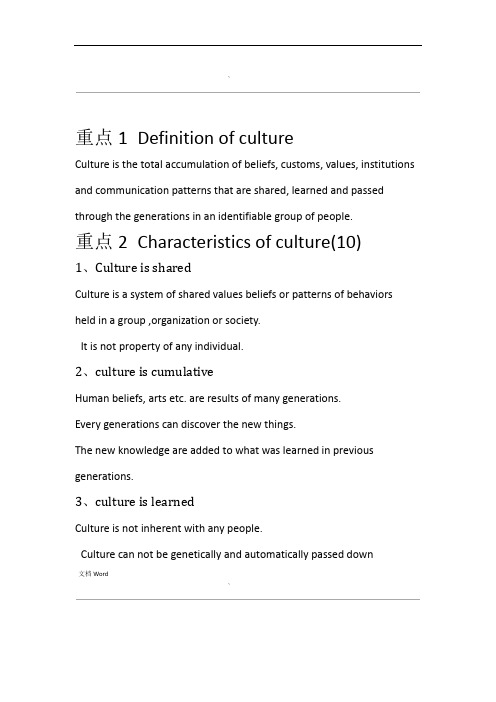
`重点1Definition of cultureCulture is the total accumulation of beliefs, customs, values, institutions and communication patterns that are shared, learned and passed through the generations in an identifiable group of people.重点2Characteristics of culture(10)1、Culture is sharedCulture is a system of shared values beliefs or patterns of behaviors held in a group ,organization or society.It is not property of any individual.2、culture is cumulativeHuman beliefs, arts etc. are results of many generations.Every generations can discover the new things.The new knowledge are added to what was learned in previous generations.3、culture is learnedCulture is not inherent with any people.Culture can not be genetically and automatically passed down文档Word`from previous generations.And it should be taught and learned by people.4、culture is adaptiveCulture is created by humans. Humans have to adapt the environment . thus is in development bears the trait of being adaptive 5、culture is dynamicAt the same time that new culture are added, and the old ones are lost because they are no longer useful.6、culture is symbolicSymbols generally serve as communicative tools for a multitude purposes, on a persons as well as culture level.7 、culture is relationalCulture is an organic whole. All the components of culture are interlinked.8 、culture is implicit and explicitSome layers culture are easy to be observe, like eating , dressing, talking. But the ideas underlying the behaviors are generally hard to know. Many scholars label the culture as iceberg.文档Word`culture is universal 9、culture is diversified、10Hall's dimensions3重点High contextHigh-context communication relies heavily on nonverbal, contextual and shared cultural meanings.The meanings are not fully expressed.re determined by “how”things are said , rather than “what”Meanings ais said.阿拉伯欧洲东部和南部日本CollectivismLow contextVerbal codes rather than the information impliesClear straight and to-the-point communication美国德国斯堪的纳维亚IndividualismMonochromic cultureDo one thing at one time, Concentrate on the job, take time seriously, 文档Word`low-context and need information, commit to the job, religiously to the plans, not disturbing others, seldom borrow or lend things, emphasize promptnessPolychromic cultureDo many things at once, subject to interruptions, consider timecommitments an objective to be achieved, high-context and already haveinformation. Change plans often. Emphasize the relationships.重点4Triandis's individualism & collectivismIndividualismFosters independence and individual achievement,Promotes self-expression ,personal choice, individual thinking Associated with egalitarian relationships and flexibility in roles Understand the physical world as knowable apart of human life CollectivismInterdependence and group successPromotes adherence to normsAssociated with stable, hierarchical rolesShared property, group ownership文档Word`重点5Elements of communication Source (sender)EncodingMessageMedium(channel)ReceiverDecodingResponseFeedback重点6Grice's cooperative principle Quantity maximMake your contribute as informative as is required for the current purpose of exchange.Do not make your contribution more information than is required. (量的准则——话语提供充分而不多余的信息)Quality maximMake your contribution is ture(质的准则——话语的容是真实的)文档Word`Relation maximBe relevant(关系准则——话语与话题有关,即与所要实现的意图有关)Manner maximBe perspicuousAvoid obscurity of expressionAvoid ambiguityDe brief and orderly(方式准则——说话要清楚明白、简洁而有条理)重点7Brown & levinson's face theory Face is something that is emotionally invested, can be lost, maintained, or enhanced, and must be often attended to in communication People cooperate while maintaining face in interaction.Face theory : face threatening acts (FTAs)Politeness strategiesPoliteness strategies: bald on-record赤裸裸的公开实行面子威胁行为不使用补救措施off-record indirect strategy 非公开的实行面子威胁行为negative politeness消极礼貌策略Positive politeness积极礼貌策略文档Word`Face: negative facePositive face重点8Thought patternsField dependence场依存性Holistic thinking eastern peoplePerspective of the whole, all the relevant parts take into account.Easily influence by othersField independence场独立性Analytic thinking western peopleDivinding the whole into parts to analyze the features or relations between the partsHardly influence by othersEastern: field-dependence, holistic thinking, high-context Western: field-independence, analytic thinking, low-context文档Word`重点9Phases of negotiation Preparation 准备Non-task sounding 非任务测探Task-oriented exchangePersuasion 劝说ConcessionConclusion重点10Components of a brandBrand name 品牌名称(产品)Brand mark 品牌标志(产品)Trade name商号(公司名字)Trade mark 品牌商标重点11SWOT analysisStrengthsWeaknessesOpportunitiesThreats文档Word`重点12Intercultural advertising strategies Standardization strategyConvey and extend the same advertising message to different markets and culturesKey point:Deal with the different markets using the same massageExample:MarlboroPhilips优点:reinforce the corporate imageSaving energyBe convenient to manage compared with several ads缺点: unlikely to be adaptive without change to all foreign culture Result in misunderstanding or conflict even ruin a business Localization strategyStresses the specialties of the local market and adaptation to the local market environment文档Word`重点13Three meaning layers of adsthe surface meaningthe intended meaningthe cultural meaning文档Word。
《跨文化交际》主要内容梳理.ppt

《跨文化交际》主要内容梳理
第二讲 语言中的文化差异1
Ⅰ.Cultural Connotations of Words:
A.Image and culture 形象与文化
狗:dog E-neutral word
C-(with derogatory sense)如:
走狗/看家狗/赖皮狗/痛打落水狗/狗东西
《跨文化交际》主要内容梳理
第一 日常谈话中的文化差异2
To American the greeting might mean this:“I
haven’t either. Come on, let’s go together and get something to eat,” or “if you haven’t,I was just going to invite you to my place.” In other words, it could indicate an invitation to a meal. When Chinese part, they usually say good-bye, bye-bye. But usually in China, it’s a custom to say请留步,慢走,走好,慢点 骑等等。
《跨文化交际》主要内容梳理
《跨文化交际》主要内容梳理
第一讲 日常谈话中的文化差异1
A.Greetings and Farewells
Westerners coming to China always feel surprised
to be told that the Chinese people often greet people with 你吃饭了没有?This, of course, is a common Chinese greeting around meal time and the people merely nodded with a smile, waved goodbye and went off. As we all realise that this remark was nothing more than a Chinese way of saying Hello or Hi. If the greeting had been put literally into English Have you eaten yet? Or Have you had your lunch? It would have sounded rather unusual.
跨文化交际 主要内容

Chapter 1Why study Intercultural communications?Four trends of the modern world make intercultural communication inevitable:1. Technological development2. Globalization of the economy3. Widespread population migrations4. Development of multiculturalismOnly through the understanding of intercultural communication can people develop a global mind-set in the global village that is our world today and live more harmoniously with one another.The field of intercultural communication has developed both theoretical and applied perspectives.1. Theoretically, the study focuses on more or less purposive interaction between people of different cultures and different racial and ethnic groups.2. Practically, intercultural communication is applied in different kinds of intercultural and interethnic training programs to help people of different backgrounds understand and accept each other in academic, business, government, and other settings.Chapter 2The relationship between Culture and Communication:Culture and communication act on each other. As the carrier of culture, commnunication influences the structure of a culture, and culture is necessarily manifested in our communication patterrns by teaching us how we should talk and behave.Communication:Communication is defined as an interdetermining process in which we develop a mutually dependent relationship by exchanging symbols.Communication has four characteristics:(1) Communication as a holistic phenomenon(2) Communicaiton as a social reality(3) Communicaiton as a developmental process(4) Communication as an orderly processCulture:Culture is defined as a negotiated set of shared symbolic systems that guide individuals’ behaviors and incline them to function as a group.Culture has four characteristics:(1) Culture is holistic(2) Culture is learned(3) Culture is dynamic(4) Culture is pervasiveCulture has two functions:(1) It provides a context in which three aspects of human society are embedded: linguistic, physical, psychological.(2) It functions to provide the structure, stability, and security that are required for the group and its members to maintain themselves as a healthy system.Intercultural communication:Intercultural communication is communication among people from two or more cultures.Successful intercultural communication is based on the positive feeling and beliefs we bring to the intercultural encounter and on the behavioral skills we possess.Three forms of intercultural communication based on the interactants’ intentions:Self-centered dialogue, Dominant dialogue, Equal dialogue.Chapter 3Perception:Perception is a process by which we turn external stimuli into meaningful experiences. The process of perception includes three stages: Selection, Organization, Interpretaion. Because perception is selective, we can only partially perceive the things that surround us, it usually follows three steps: Selective exposure, Selective attention, Selective retention. Organization refers to the way we arrange what we perceive into meaningful patterns, based on their shape, color, texture, size, and intensity. Interpretation is the process whereby we assign meanings to what we perceive.Culture has a major impact on the perception process: It not only provides the foundation for the meanings we assign to our perceptions, it also determines how we choose to expose ourselves to and direct our attention toward specific kinds of messages and events.The influence of culture on perception is often reflected in the attributional process. Attr ibution involves interpreting the meaning of others’ behaviors based on our past experience or history. Culture provides an environment that allows us to develop all the meanings we possess. Thus, people from different cultures will perceive and interpret others’ behaviors in different ways.The subjective nature of the perceptual framework arising from our culture indicates that our perception is often partial and inaccurate. The insufficiency manifests as stereotyping, prejudice, and discrimination.Stereotypes are those overgeneralized and oversimplified beliefs we use to categorize a group of people.Prejudice is a regid attitude based on erroneous beliefs or preconceptions. Discrimination is the acting out of prejudicial attitudes.Stereotypes an prejudice do not suddenly appear when we are born, they are gradually developed from the process of learning and socialization, and from exposure to mass media images. To solvethe problems of stereotypes and prejudice the most important communication skill we should learn is empathy.Values:A value can be defined as a conception, explicit or implicit, distinctive of an individual or characteristic of a group, of the desirable which influences the selection from available modes, means, and ends of action. Values are guiding forces of human behavior.Culture value orientation is the concept used to study the relationship between cultural values and communications behaviors, it refers to the means society uses to solve the universal problems of daily life.Power distance specifies to what extent a culture adapts to inequalities of power distribution in relationships and organizations.High-power-distance culture tend to orient to authoritarianism, which dictates a hierarchical or vertical structure of social relationships.Low-power-distance cultures are more horizontal in terms of social relationships.Chapter 4Linguistics is the scientific study of human language. It consists of five areas of study: Morphology, Phonology, Syntax, Semantics, Pragmatics. Semantics and pragmatics directly affect the process of intercultural communication.Human language has four characteristics: (1)It’s symbolic; (2)It’s rule-governed; (3)It’s subjective; (4)It often shows change and variation.Language is a bridge people can use to learn or understand cultural values, and it’s necessary to comprehend cultural values to acquire the language used to portray them. In other words, to be competent in intercultural communication we need to be aware of both the cultural values and the language expressions of our cultural counterparts.Chapter 5Verbal and nonverbal communication form the two main contexts of human communication.Nonverbal communication is different from verbal communication in five respects:1. It’s not consciously controllable2. It can indicate multiple events simultaneously3. It can be used as an intercultural or international language4. It’s learned earlier in our life.5. It’s more emotional in expressionFive functions of nonverbal communication: repetition, replacement, emphasis, contradiction, regulation.Characteristics of nonverbal communication: Nonverbal communication is less systemized and more culturally bound, and its meanings are always ambiguous.The structure of nonverbal communication is comprised of four areas of study:1. Kinesics is the study of body movements such as facial expressions, eye contact, hand gestures, and touch.2. Proxemics is the study of how human beings and animals use space in communication.3. Paralanguage refers to how we use voice dimensions: voice quality, vocal characterizers, vocal qualifiers, and vocal segregates.4. Chronemics is the study of how we perceive the concept of time and how that affects our communication.Nonverbal communication and culture are closely interrelated in two ways:First, our nonverbal behaviors are dictated by our culture;Second, culture determines when it’s appropriate time for us to display nonverbal behaviors.We can improve our intercultural skills in nonverbal communication by following Ricard’s five-step model for the development of nonverbal skills:1. Assess our learning needs2. Observe similar situations3. Use appropriate resources4. Reach tentative conclusions5. Reevaluate our conclusions as necessary.Chapter 6We develop relationships to meet the social needs of inclusion, control, and affection. Human relationship has five characteristics:1. It’s dynamic2. It’s hierarchical3. It’s reciprocal4. It’s unique5. It’s interdependent and irreplaceableTheories of relationship development:1. Social Exchange Theory: Social interaction relationship initiates after measuring the difference between reward and costs.2. Social Penetration Theory: The development of human relationships is determined by the information we disclose to our partner.3. Uncertainty Reduction Theory: This theory posits that interpersonal relationships develop and progress when we are able to reduce our uncertainty about each other.4. Communication Accommodation Theory: It combines propositions from speech accommodation theory and ethnolinguistic identity theory to examine the communicative moves interactants make in social and psychological contexts and how it’s related to personal characteristics.Yum’s five categories of relationship are used to illus trate the impact of culutral variability on relationship development. The five categories areparticularism/universalism, long-term/short-term, ingroup/outgroup, formal/informal, and personal/public relationships. The inluence of cultural value differences are also discussed from the following perspectives: verbal/nonverbal differences, background and attitude information, and the degree of self-disclosure.Third-Culture-Building: five phases of third-culture building are explicated: intrapersonal intracultural communication, interpersonal intercultural communication, rhetorical intercultural communication, metacultural communication, and intracultural commmunication.Chapter 7Conflicts are inevitable in the process of intercultural communication. To have unpleasant feelings during conflict is universal. Conflicts can be considered as seveal levels: intrapersonal conflict, interpersonal conflict, intergroup conflict, and interorganizational conflict.The impact of culture on conflict and conlict management are discussed from three perspectives: 1. Thinking patterns; 2. Language barriers; 3. Cultural context.The factors that affect our reactions and decisions in a conflict situation are delineated: face, interrelation, favor, seniority, status, power, credibility, interest, severity of the conflict, and gender.Two methods for the effective management of intercultural conflicts are suggested.The first method is based on Harris and Moran’s model of conflict management, which includes five steps: 1.Describe the conflict in a way understood in both cultures;2,Analyze the conflict from both cultural perspectives; 3.Identify the basis for the conflict from two culural viewpoints; 4.Solve the conflict through synergistic strategies;5.Determine if the solution is working interculturally.The second method is based on Ting-Toomey’s suggestions for handling conflicts in individualistic and collectivistic cultures.Chapter 8Increasing contact among people from different cultures around the globle demands understanding of the process of intercultural adaptation. Intercultural adaptation refers broadly to the process of increasing our level of fitness to meet the demands of a new cultural environment. It deals with how sojourners or new immigrants experience the distress caused by mismatches or incompatibility between the host culture and the culture of birth. In other words, intercultural adaptation is a process of dealing with maladjustment within a host culture.What’s Culture shock?Brief introduction: It’s the reaction of sojourners to problems encountered in the dealings with the host members or culture. It results from the processing of stressful situaions, especially attempts to establish and maintain a relationship with those of the host culture.Six aspects of Culture shock:1. A feeling of strain that comes from our attempts at psychological adjustments2. A feeling of loss regarding friends and family, social status, and possessions3. A feeling of being rejected by or rejecting the host nationals4. A feeling of confusion in beliefs, values, and role expectations5. A generalized feeling of anxiety, disgust, or surprise in the face of cultural differences6. A feeling of importance for being unable to cope with aspects of the new environment. Forms of culture shock:Language shock, role shock, transition shock, culture shock, culture fatigue, education shock, adjustment stress, and culture distance.Symptoms of culture shock:Depression, helplessness, hostility to the host country, feelings of anxiety, overidentification with our home country, feelings of withdrawal, homesickness, loneliness, paranoid feelings, preoccupation with cleanliness, irritablity, confusion, disorientation, isolation, tension, need to establish continuty, defensiveness, intolerance of ambiguity, and impatience.Positive effects of culture shock:1. It provides a learning opportunity that demands new responses from sojourners in coping with a constantly changing environment.2. It can creat an environment and serve as a motivational force for us to move to new levels of self-actualization.3. It can give sojourners a welcome sense of challenge and achievement as a result of dealing with people from very different backgrounds.4. The amount of learning increases when the level of personal anxiety is aroused to a certain degree.5. The experience from culture shock produces new ideas6. This practice helps us to deal with cultures that we have not yet experienced.Negative effects of culture shock:1. Affectively, culture shock constitutes an imbalancing experience2. Cognitively and perceptually, a set of desirable or proper behaviors in one culture might be considered strange in another.U-curve pattern of intercultural adaptation is comprised of four stages: 1.Honeymoon period; 2.Crisis period; 3.Adjustment period; 4.Biculturalism period.W-curve pattern is also used to explicate the reentry adapation process.A dialectical model:1. Intercultural adaptation is a motivated, goal-oriented process2.The intercultural adapation and learning processes are reciprocal and interdependent3.Intercultural adapation implies a stranger-host relationship4,Intercultural adapation is a cyclical, continuous, and interactive process5.Intercultural adaptation is ongoing6.Intercultural adapattion implies personal development.A transformative learning model: It consists of three dimensions: the precondition to change, the process, and the outcome.Chapter 10Intercultural understanding is absolutely vital for people to lead harmonious and meaningful lives together in a culturally pluralistic world.Four strategies of diversity management for organizations:1.Managing and rewarding performance based on the foundation of diversity2.Matching people and jobs3.Keeping employees informed and involved4.Supporting diverse work styles and life needs.Four significant issues regarding multicultural education are considered:1.Exposure to multicultural perspectives2.Maintaining cultural indentity3.Developing intercultural communication skills4.Diversifying the curriculumSeven stages of the process of multiculturalism:1.Monoculturalism2.Cross-cultural contact3.Cultural conflictcational interventions5.Disequilibrium6.Awareness7.MulticulturalismIntercultural sensitivity is a dynamic and a multidimensional concept describing individual’s active desire to motivate themselves to understand, appreciate, and accept differences among cultures.The effective way to develop intercultural sensitivity is to take intercultural training process. It aims to develop an appreciation and understanding of cross-cultural differences and to some of the necessary abilities.Components of Intercultural sensitivity: Ethnorelativism, respect for cultural differences, adaptablity, perspective-taking, open-mindedness, and acknowledgment of other’s needs.Chapter 11Only with mastery of intercultural communication competence can persons from different cultures communicate effectively and appropriately.What’s competence?Competence is defined as an organization’s capacity to interact effectively with its environment or as the acquired ability to interact effectively.Communication competence is comprised of two elements: effectiveness and appropriateness.Intercultural communication competence is defined as the ability to effectively and appropriately execute communication behaviors to elicit a desired response in a specific environment.Intercultural communication competence has four dimensions:1.Personality attributes: Including self-concept, self-disclosure, self-awareness, social relaxationmunication skills: message siklls, behavioral flexibility, interaction management, social skills3.Psychological adjustment: it refers to the ability to acclimate to a new culture4.Cultural awareness: refers to understanding the conventions of the host culture that affect how people think and behave.Chapter 12Goals of intercultural training: We must develop the ability to expand our worldviewby increasing our understanding of culture and its impact on communication behaviors; enhance our ability to recognize and appreciate cultural similarities and differences; and further improve our skills of intercultural communication. Only through the process of intercultural training can we effectively achieve these goals.Six training models: the classroom model, the simulation model, the self-awareness model, the cultural awareness model, the behavioral model, the interactional model. Five common techniques used in the trainning models: role playing, case studies, critical incidents, cultural assimilators, simulations, examines the procedures used to evaluate intercultural training programs.Chapter 13Ethics can be defined as the science of judging human ends and the relationship of means to those ends, and the art of controlling means so that they will serve specially human ends.Theories of Ethical study:Universalism vs. Relativism, Objectivism vs. Subjectivism, Attitudinalism vs. Consequentialism, Deontologism vs. Teleologism.Principles of ethical intercultural communication:Mutuality, Nonjudgmentalism, Honesty, Respect.Ethical rules for intercultural communication:1.Promote voluntary participation in the interaction2.Seek individual focus prior to cultural focus3.Maintain the right to freedom from harm4.Accept the right to privacy of thought and action5.Avoid imposing personal biasesThe discussion of the future of intercultural communication is divided into three parts.1.Increasing or decreasing intercultural communication is discussed from domestic and international perspectives.2.Unity versus division is discussed from two angles: ethnocentrism and gender impact.3.The future study of intercultural communication is explained from three perspectives: education, business, and research中文版本,帮助理解:第一章.为什么要学习跨文化交流?学习跨文化的四个原因〔四个趋向〕1.科技开展2.世界经济全球化3.大规模人口迁移4.多元文化主义的开展面对新的国际形势,研究跨文化交际活动,可以让社会更加和谐的开展,让人能够与更好的与其他文化的人进行交往。
跨文化交际重点梳理
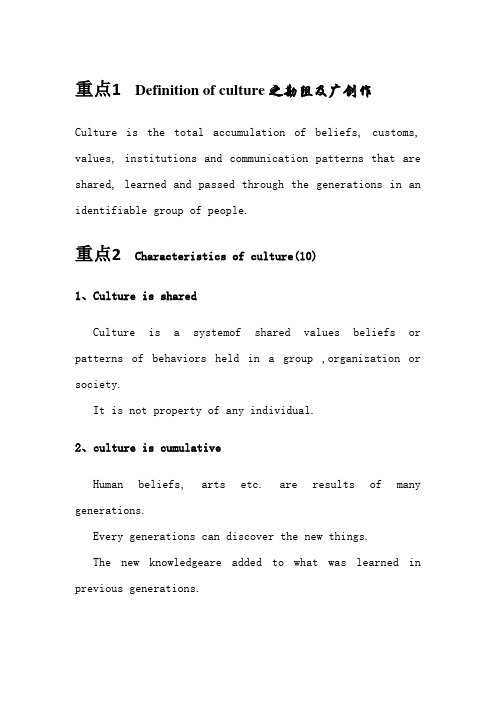
重点1Definition of culture之勘阻及广创作Culture is the total accumulation of beliefs, customs, values, institutions and communication patterns that are shared, learned and passed through the generations in an identifiable group of people.重点2Characteristics of culture(10)1、Culture is sharedCulture is a systemof shared values beliefs or patterns of behaviors held in a group ,organization or society.It is not property of any individual.2、culture is cumulativeHuman beliefs, arts etc. are results of many generations.Every generations can discover the new things.The new knowledgeare added to what was learned in previous generations.3、culture is learnedCulture is not inherent with any people.Culture can not be genetically and automatically passed down from previous generations.And it should be taught and learned by people.4、culture is adaptiveCulture is created by humans. Humans have to adapt the environment .thus is in development bears the trait of being adaptive5、culture is dynamicAt the same time that new culture are added, and the old ones are lost because they are no longer useful.6、culture is symbolicSymbols generally serve as communicative tools for a multitude purposes, on a persons as well as culture level.7 、culture is relationalCulture is an organic whole. All the components of culture are interlinked.8 、culture is implicit and explicitSome layers culture are easy to be observe, like eating , dressing, talking. But the ideas underlying the behaviors are generally hard to know. Many scholars label the culture as iceberg.9、 culture is universal10 、culture is diversified重点3Hall’s dimensionsHigh contextHigh-context communication relies heavily on nonverbal, contextual and shared cultural meanings.The meanings are not fully expressed.Meanings are determined by “how” things are said , rather than “what” is said.日本欧洲东部和南部阿拉伯CollectivismLow contextVerbal codes rather than the information impliesClear straight and to-the-point communication美国德国斯堪的纳维亚IndividualismMonochromic cultureDo one thing at one time, Concentrate on the job, take time seriously, low-context and need information, commit to the job, religiously to the plans, not disturbing others, seldom borrow or lend things, emphasize promptnessPolychromic cultureDo many things at once, subject to interruptions, consider time commitments an objective to be achieved, high-context and already have information. Change plans often. Emphasize the relationships.重点4Triandis’s individualism & collectivism IndividualismFosters independence and individual achievement, Promotes self-expression ,personal choice, individual thinkingAssociated with egalitarian relationships and flexibility in rolesUnderstand the physical world as knowable apart of human lifeCollectivismInterdependence and group successPromotes adherence to normsAssociated with stable, hierarchical rolesShared property, group ownership重点5Elements of communicationSource (sender)EncodingMessageMedium(channel)ReceiverDecodingResponseFeedback重点6Grice’s cooperative principleQuantity maximMake your contribute as informative as is required for the current purpose of exchange.Do not make your contribution more information than is required.(量的准则——话语提供充分而未几余的信息)Quality maximMake your contribution is ture(质的准则——话语的内容是真实的)Relation maximBe relevant(关系准则——话语与话题有关,即与所要实现的意图有关)Manner maximBe perspicuousAvoid obscurity of expressionAvoid ambiguityDe brief and orderly(方式准则——说话要清楚明白、简洁而有条理)重点7Brown & levinson’s face theoryFace is something that is emotionally invested, can be lost, maintained, or enhanced, and must be often attended to in communicationPeople cooperate while maintaining face in interaction. Face theory : face threatening acts (FTAs)Politeness strategiesPoliteness strategies:bald on-record不使用解救措施赤裸裸的公开实行面子威胁行为off-record indirect strategy非公开的实行面子威胁行为negative politeness消极礼貌战略Positive politeness积极礼貌战略Face: negative facePositive face重点8Thought patternsField dependence场依存性Holistic thinking eastern peoplePerspective of the whole, all the relevant parts take into account.Easily influence by othersField independence场独立性Analytic thinking western peopleDivinding the whole into parts to analyze the features or relations between the partsHardly influence by othersEastern: field-dependence, holistic thinking, high-contextWestern: field-independence, analytic thinking, low-context重点9Phases of negotiationPreparation 准备Non-task sounding 非任务测探Task-oriented exchangePersuasion 劝说ConcessionConclusion重点10Components of a brandBrand name品牌名称(产品)Brand mark 品牌标记(产品)Trade name商号(公司名字)Trade mark 品牌商标重点11SWOT analysisStrengthsWeaknessesOpportunitiesThreats重点12Intercultural advertising strategies Standardization strategyConvey and extend the same advertising message to different markets and culturesKey point:Deal with the different markets using the same massage Example:MarlboroPhilips优点:reinforce the corporate imageSaving energyBe convenient to manage compared with several ads缺点: unlikely to be adaptive without change to all foreign cultureResult in misunderstanding or conflict even ruin a businessLocalization strategyStresses the specialties of the local market and adaptation to the local market environment重点13Three meaning layers of adsthe surface meaningthe intended meaningthe cultural meaning。
跨文化交际全书要点总结
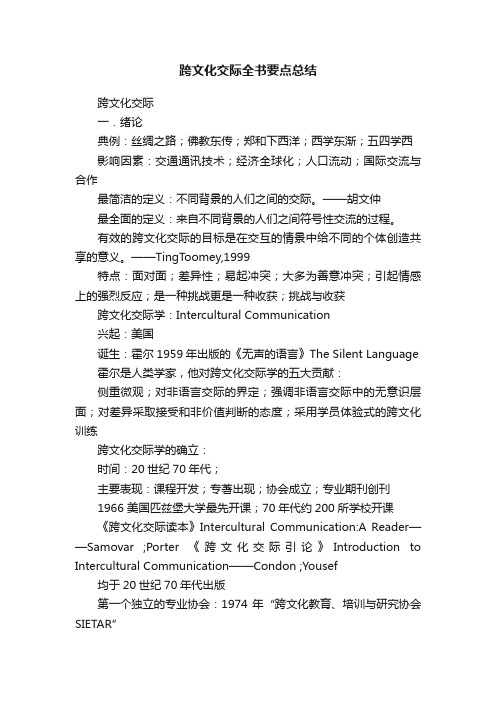
跨文化交际全书要点总结跨文化交际一.绪论典例:丝绸之路;佛教东传;郑和下西洋;西学东渐;五四学西影响因素:交通通讯技术;经济全球化;人口流动;国际交流与合作最简洁的定义:不同背景的人们之间的交际。
——胡文仲最全面的定义:来自不同背景的人们之间符号性交流的过程。
有效的跨文化交际的目标是在交互的情景中给不同的个体创造共享的意义。
——TingToomey,1999特点:面对面;差异性;易起冲突;大多为善意冲突;引起情感上的强烈反应;是一种挑战更是一种收获;挑战与收获跨文化交际学:Intercultural Communication兴起:美国诞生:霍尔1959年出版的《无声的语言》The Silent Language 霍尔是人类学家,他对跨文化交际学的五大贡献:侧重微观;对非语言交际的界定;强调非语言交际中的无意识层面;对差异采取接受和非价值判断的态度;采用学员体验式的跨文化训练跨文化交际学的确立:时间:20世纪70年代;主要表现:课程开发;专著出现;协会成立;专业期刊创刊1966 美国匹兹堡大学最先开课;70年代约200所学校开课《跨文化交际读本》Intercultural Communication:A Reader——Samovar ;Porter 《跨文化交际引论》Introduction to Intercultural Communication——Condon ;Yousef均于20世纪70年代出版第一个独立的专业协会:1974年“跨文化教育、培训与研究协会SIETAR”第一届跨文化交际学国际研讨会:1972年;东京两个最有影响力的学术期刊:International and Intercultural Communication Annals ,1974 International Journal of Intercultural Relations,1977跨文化交际学的成熟(20世纪80年代后)成熟标志:各种理论模式的诞生和研究方法的探索Gudykunst(2003)总结了跨文化交际的15种理论,如:不确定性的减少理论;文化身份的协商理论;面子协商理论;归因理论;跨文化交际网络理论、适应理论、文化尺度理论---提供理论框架Bennett(1998)指出跨文化交际学领域存在两种学派:理论-理论学派主要阵地:传播学理论-实践学派侧重应用和跨文化训练如:跨文化交际与外语教育、商务管理跨文虎交际学的理论基础:Hart(1999)经调查,对其影响最大的学科:人类学、心理学、语言学、社会学、传播学人类学最早影响三大贡献:1、文化定义2、文化与语言的关系(萨丕尔-沃尔夫假说)3、文化相对主义的态度(平等无贵贱)心理学——跨文化心理学主研:主观文化、文化适应研究(模式、策略、休克)语言学——社会语言学和语用学Leech的礼貌原则;Brown和Levinson的面子与礼貌策略社会学——社会心理学传播学——主要阵地和学科归属贡献:建构跨文化交际理论Gudykunst:陌生人理论;焦虑-不确定性的减少理论;TingT oomey:文化身份的协商理论;面子协商理论跨文化交际研究方法人类学背景:观察、访谈心理学、社会学背景:量化大规模数据调查语言学背景:话语分析(文化含义和使用规则)综合:以实证研究为主、尤其是量化的方法客位(旁观者视角)(一般文化)(系统外部)(创建文化模式)主位(从圈内人的角度)(特殊文化)(系统内部)(发现文化模式)如:本尼迪克特《菊与刀》斯图尔特与贝尔特《美国文化模式》中国跨文化交际研究20世纪80年代引入胡文仲等学者最先介绍北外、哈师大、福建师大最先开课1995哈工大召开中国第一届跨文化交际研讨会,并成立中国跨文化交际学会集中研究:中西习俗对比、中西经营管理模式、国民性、价值观、非语言交际影响著作:关世杰《跨文化交际学》林大津《跨文化交际研究:与英美人交往指南》;贾玉新《跨文化交际学》胡文仲《跨文化交际概论》总之:起步晚;范围窄,主要集中在外语教育和对外汉语教学领域,研究成果主要是跨文化语用学,实证性研究少汉语教师学习跨文化交际的必要性:1、更好地理解祖国文化2、建立敏锐的跨文化意识3、提高文化适应能力4、建立开放宽容尊重的文化态度5、建立在异域环境教汉语的针对性和有效性6、培养学生的交际能力的策略跨文化交际能力的定义:Fantini(2006):与异文化的人们进行有效而得体的交往所需的综合能力。
跨文化交际
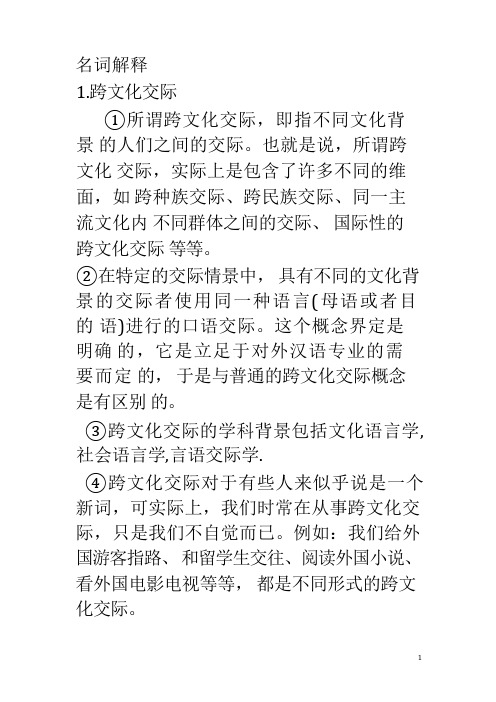
名词解释1.跨文化交际①所谓跨文化交际,即指不同文化背景的人们之间的交际。
也就是说,所谓跨文化交际,实际上是包含了许多不同的维面,如跨种族交际、跨民族交际、同一主流文化内不同群体之间的交际、国际性的跨文化交际等等。
②在特定的交际情景中,具有不同的文化背景的交际者使用同一种语言(母语或者目的语)进行的口语交际。
这个概念界定是明确的,它是立足于对外汉语专业的需要而定的,于是与普通的跨文化交际概念是有区别的。
③跨文化交际的学科背景包括文化语言学, 社会语言学,言语交际学.④跨文化交际对于有些人来似乎说是一个新词,可实际上,我们时常在从事跨文化交际,只是我们不自觉而已。
例如:我们给外国游客指路、和留学生交往、阅读外国小说、看外国电影电视等等,都是不同形式的跨文化交际。
2.文化定势世界上大多数社会中都可能存在着若干群体或者社团,这些群体或者社团对地域、历史、生活方式以及价值观等方面的共享,使其成员形成、发展并强化了自己独特的文化及与之相适应的交际文化。
在跨文化交际研究中,学者们往往倾向于把某一文化群体的每一个成员都视为该文化定势的代表或者整体文化形象。
这种整体式的文化取向通常被称为文化定势。
3.价值观①在跨文化交际研究中,价值观是个至关重要的问题。
价值观是文化的底层,不理解其差异就不能理解不同文化之间的根本差异。
②价值观对人类的活动起着规定性或者指令性的作用,是人们行为的规则、思维的方式、认知的准绳、处世的哲学、推理的模式、评价的依据、道德的标准。
人们在不知不觉中通过交际习得这套价值系统,它变成为了他们的集体无意识,变成为了他们的信仰、心态、行为、生活等诸方面的可评价系统,变成为了他们民族性格的基石。
每一种文化都有其独特的一套系统,而价值观是它的核心。
③价值观总是相对稳定的,一个人的价值观是从出生开始,在家庭和社会的影响下逐步形成的。
一个人所处的社会生产方式及其所处的经济地位,对其价值观的形成有决定性的影响;同时舆论宣传,以及父母、老师、朋友和公众名人的观点与行为,对一个人的价值观形成也有不可忽视的作用4.体态语体态语( body language )是非语言交际的重要组成部份,它包括眼神、手势、身势、面部表情、体距、体触等。
大学英语跨文化交际教材梗概
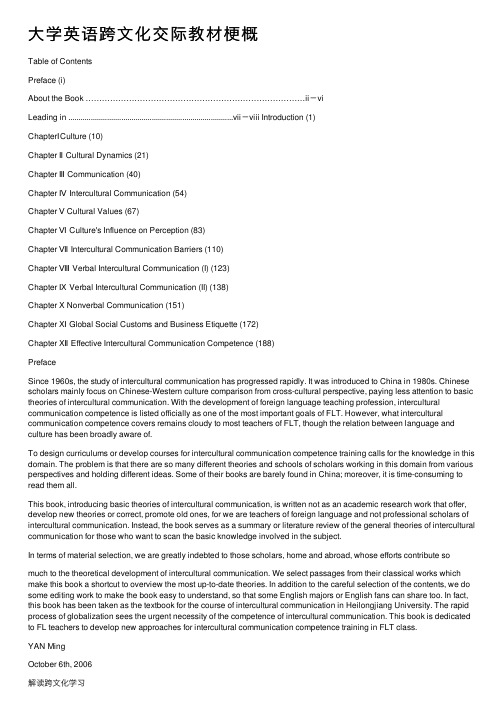
⼤学英语跨⽂化交际教材梗概Table of ContentsPreface (i)About the Book ………………………………………………………………………ii-viLeading in .................................................................................vii-viii Introduction (1)ChapterⅠCulture (10)Chapter Ⅱ Cultural Dynamics (21)Chapter Ⅲ Communication (40)Chapter Ⅳ Intercultural Communication (54)Chapter Ⅴ Cultural Values (67)Chapter Ⅵ Culture's Influence on Perception (83)Chapter Ⅶ Intercultural Communication Barriers (110)Chapter Ⅷ Verbal Intercultural Communication (I) (123)Chapter Ⅸ Verbal Intercultural Communication (II) (138)Chapter Ⅹ Nonverbal Communication (151)Chapter Ⅺ Global Social Customs and Business Etiquette (172)Chapter Ⅻ Effective Intercultural Communication Competence (188)PrefaceSince 1960s, the study of intercultural communication has progressed rapidly. It was introduced to China in 1980s. Chinese scholars mainly focus on Chinese-Western culture comparison from cross-cultural perspective, paying less attention to basic theories of intercultural communication. With the development of foreign language teaching profession, intercultural communication competence is listed officially as one of the most important goals of FLT. However, what intercultural communication competence covers remains cloudy to most teachers of FLT, though the relation between language and culture has been broadly aware of.To design curriculums or develop courses for intercultural communication competence training calls for the knowledge in this domain. The problem is that there are so many different theories and schools of scholars working in this domain from various perspectives and holding different ideas. Some of their books are barely found in China; moreover, it is time-consuming to read them all.This book, introducing basic theories of intercultural communication, is written not as an academic research work that offer, develop new theories or correct, promote old ones, for we are teachers of foreign language and not professional scholars of intercultural communication. Instead, the book serves as a summary or literature review of the general theories of intercultural communication for those who want to scan the basic knowledge involved in the subject.In terms of material selection, we are greatly indebted to those scholars, home and abroad, whose efforts contribute so much to the theoretical development of intercultural communication. We select passages from their classical works which make this book a shortcut to overview the most up-to-date theories. In addition to the careful selection of the contents, we do some editing work to make the book easy to understand, so that some English majors or English fans can share too. In fact, this book has been taken as the textbook for the course of intercultural communication in Heilongjiang University. The rapid process of globalization sees the urgent necessity of the competence of intercultural communication. This book is dedicated to FL teachers to develop new approaches for intercultural communication competence training in FLT class.YAN MingOctober 6th, 2006解读跨⽂化学习―跨⽂化学习‖是指个体在不同的⽂化交流互动中习得知识、态度和⾏为的过程。
(完整版)跨文化交际
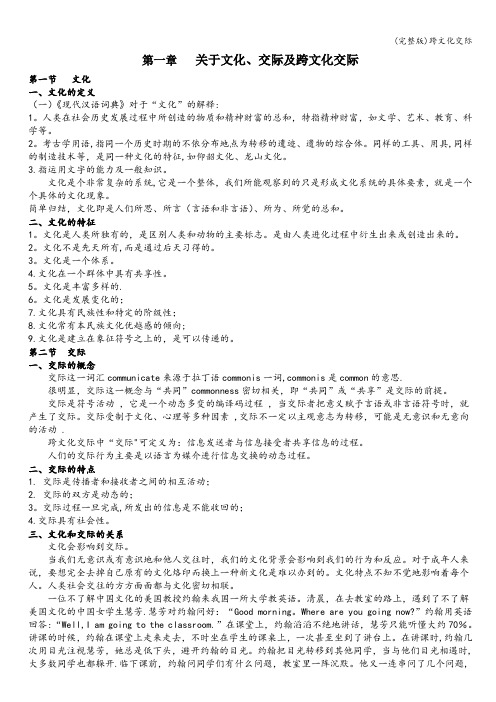
第一章关于文化、交际及跨文化交际第一节文化一、文化的定义(一)《现代汉语词典》对于“文化”的解释:1。
人类在社会历史发展过程中所创造的物质和精神财富的总和,特指精神财富,如文学、艺术、教育、科学等。
2。
考古学用语,指同一个历史时期的不依分布地点为转移的遗迹、遗物的综合体。
同样的工具、用具,同样的制造技术等,是同一种文化的特征,如仰韶文化、龙山文化。
3.指运用文字的能力及一般知识。
文化是个非常复杂的系统,它是一个整体,我们所能观察到的只是形成文化系统的具体要素,就是一个个具体的文化现象。
简单归结,文化即是人们所思、所言(言语和非言语)、所为、所觉的总和。
二、文化的特征1。
文化是人类所独有的,是区别人类和动物的主要标志。
是由人类进化过程中衍生出来或创造出来的。
2。
文化不是先天所有,而是通过后天习得的。
3。
文化是一个体系。
4.文化在一个群体中具有共享性。
5。
文化是丰富多样的.6。
文化是发展变化的;7.文化具有民族性和特定的阶级性;8.文化常有本民族文化优越感的倾向;9.文化是建立在象征符号之上的,是可以传递的。
第二节交际一、交际的概念交际这一词汇communicate来源于拉丁语commonis一词,commonis是common的意思.很明显,交际这一概念与“共同”commonness密切相关,即“共同”或“共享”是交际的前提。
交际是符号活动,它是一个动态多变的编译码过程,当交际者把意义赋予言语或非言语符号时,就产生了交际。
交际受制于文化、心理等多种因素 ,交际不一定以主观意志为转移,可能是无意识和无意向的活动 .跨文化交际中“交际"可定义为:信息发送者与信息接受者共享信息的过程。
人们的交际行为主要是以语言为媒介进行信息交换的动态过程。
二、交际的特点1. 交际是传播者和接收者之间的相互活动;2. 交际的双方是动态的;3。
交际过程一旦完成,所发出的信息是不能收回的;4.交际具有社会性。
三、文化和交际的关系文化会影响到交际。
跨文化交际重点梳理
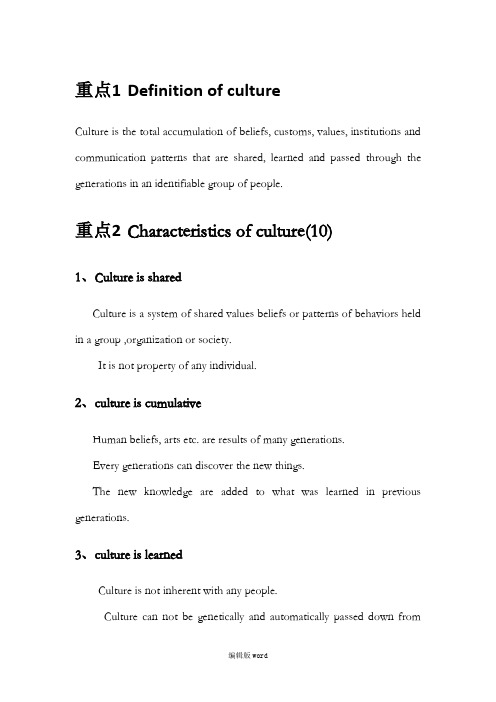
重点1Definition of cultureCulture is the total accumulation of beliefs, customs, values, institutions and communication patterns that are shared, learned and passed through the generations in an identifiable group of people.重点2Characteristics of culture(10)1、Culture is sharedCulture is a system of shared values beliefs or patterns of behaviors held in a group ,organization or society.It is not property of any individual.2、culture is cumulativeHuman beliefs, arts etc. are results of many generations.Every generations can discover the new things.The new knowledge are added to what was learned in previous generations.3、culture is learnedCulture is not inherent with any people.Culture can not be genetically and automatically passed down fromprevious generations.And it should be taught and learned by people.4、culture is adaptiveCulture is created by humans. Humans have to adapt the environment . thus is in development bears the trait of being adaptive5、culture is dynamicAt the same time that new culture are added, and the old ones are lost because they are no longer useful.6、culture is symbolicSymbols generally serve as communicative tools for a multitude purposes, on a persons as well as culture level.7 、culture is relationalCulture is an organic whole. All the components of culture are interlinked.8 、culture is implicit and explicitSome layers culture are easy to be observe, like eating , dressing, talking. But the ideas underlying the behaviors are generally hard to know. Many scholars label the culture as iceberg.9、culture is universal10 、culture is diversified重点3Hall’s dimensionsHigh contextHigh-context communication relies heavily on nonverbal, contextual and shared cultural meanings.The meanings are not fully expressed.Meanings are determined by “how”things are said , rather than “what” is said.日本欧洲东部和南部阿拉伯CollectivismLow contextVerbal codes rather than the information impliesClear straight and to-the-point communication美国德国斯堪的纳维亚IndividualismMonochromic cultureDo one thing at one time, Concentrate on the job, take time seriously,low-context and need information, commit to the job, religiously to the plans, not disturbing others, seldom borrow or lend things, emphasize promptnessPolychromic cultureDo many things at once, subject to interruptions, consider time commitments an objective to be achieved, high-context and already have information. Change plans often. Emphasize the relationships.重点4Triandis’s individualism & collectivism IndividualismFosters independence and individual achievement,Promotes self-expression ,personal choice, individual thinking Associated with egalitarian relationships and flexibility in roles Understand the physical world as knowable apart of human life CollectivismInterdependence and group successPromotes adherence to normsAssociated with stable, hierarchical rolesShared property, group ownership重点5Elements of communicationSource (sender)EncodingMessageMedium(channel)ReceiverDecodingResponseFeedback重点6Grice’s cooperative principleQuantity maximMake your contribute as informative as is required for the current purpose of exchange.Do not make your contribution more information than is required.(量的准则——话语提供充分而不多余的信息)Quality maximMake your contribution is ture(质的准则——话语的内容是真实的)Relation maximBe relevant(关系准则——话语与话题有关,即与所要实现的意图有关)Manner maximBe perspicuousAvoid obscurity of expressionAvoid ambiguityDe brief and orderly(方式准则——说话要清楚明白、简洁而有条理)重点7Brown & levinson’s face theoryFace is something that is emotionally invested, can be lost, maintained, or enhanced, and must be often attended to in communicationPeople cooperate while maintaining face in interaction.Face theory : face threatening acts (FTAs)Politeness strategiesPoliteness strategies: bald on-record不使用补救措施赤裸裸的公开实行面子威胁行为off-record indirect strategy非公开的实行面子威胁行为negative politeness消极礼貌策略Positive politeness积极礼貌策略Face: negative facePositive face重点8Thought patternsField dependence场依存性Holistic thinking eastern peoplePerspective of the whole, all the relevant parts take into account.Easily influence by othersField independence场独立性Analytic thinking western peopleDivinding the whole into parts to analyze the features or relations between the partsHardly influence by othersEastern: field-dependence, holistic thinking, high-contextWestern: field-independence, analytic thinking, low-context重点9Phases of negotiationPreparation 准备Non-task sounding 非任务测探Task-oriented exchangePersuasion 劝说ConcessionConclusion重点10Components of a brandBrand name 品牌名称(产品)Brand mark 品牌标志(产品)Trade name商号(公司名字)Trade mark 品牌商标重点11SWOT analysisStrengthsWeaknessesOpportunitiesThreats重点12Intercultural advertising strategies Standardization strategyConvey and extend the same advertising message to different markets and culturesKey point:Deal with the different markets using the same massageExample:MarlboroPhilips优点:reinforce the corporate imageSaving energyBe convenient to manage compared with several ads缺点: unlikely to be adaptive without change to all foreign culture Result in misunderstanding or conflict even ruin a business Localization strategyStresses the specialties of the local market and adaptation to the local market environment重点13Three meaning layers of adsthe surface meaningthe intended meaningthe cultural meaning(此文档部分内容来源于网络,如有侵权请告知删除,文档可自行编辑修改内容,供参考,感谢您的配合和支持)。
跨文化交际 知识点整理
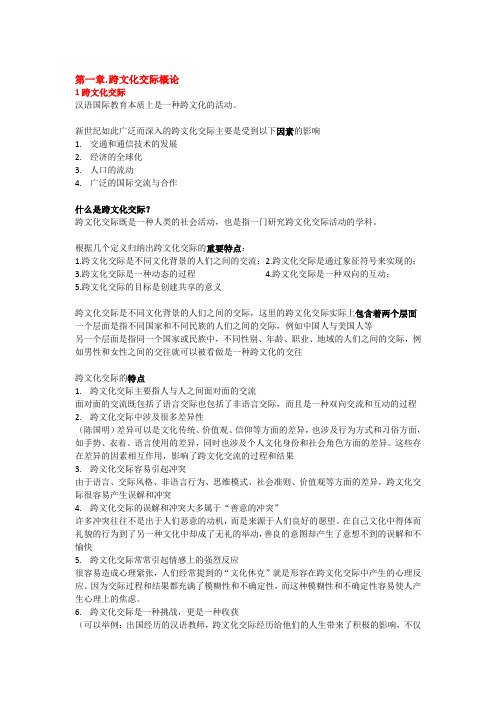
第一章.跨文化交际概论1跨文化交际汉语国际教育本质上是一种跨文化的活动。
新世纪如此广泛而深入的跨文化交际主要是受到以下因素的影响1.交通和通信技术的发展2.经济的全球化3.人口的流动4.广泛的国际交流与合作什么是跨文化交际?跨文化交际既是一种人类的社会活动,也是指一门研究跨文化交际活动的学科。
根据几个定义归纳出跨文化交际的重要特点:1.跨文化交际是不同文化背景的人们之间的交流;2.跨文化交际是通过象征符号来实现的;3.跨文化交际是一种动态的过程4.跨文化交际是一种双向的互动;5.跨文化交际的目标是创建共享的意义跨文化交际是不同文化背景的人们之间的交际,这里的跨文化交际实际上包含着两个层面一个层面是指不同国家和不同民族的人们之间的交际,例如中国人与美国人等另一个层面是指同一个国家或民族中,不同性别、年龄、职业、地域的人们之间的交际,例如男性和女性之间的交往就可以被看做是一种跨文化的交往跨文化交际的特点1.跨文化交际主要指人与人之间面对面的交流面对面的交流既包括了语言交际也包括了非语言交际,而且是一种双向交流和互动的过程2.跨文化交际中涉及很多差异性(陈国明)差异可以是文化传统、价值观、信仰等方面的差异,也涉及行为方式和习俗方面,如手势、衣着、语言使用的差异,同时也涉及个人文化身份和社会角色方面的差异。
这些存在差异的因素相互作用,影响了跨文化交流的过程和结果3.跨文化交际容易引起冲突由于语言、交际风格、非语言行为、思维模式、社会准则、价值观等方面的差异,跨文化交际很容易产生误解和冲突4.跨文化交际的误解和冲突大多属于“善意的冲突”许多冲突往往不是出于人们恶意的动机,而是来源于人们良好的愿望。
在自己文化中得体而礼貌的行为到了另一种文化中却成了无礼的举动,善良的意图却产生了意想不到的误解和不愉快5.跨文化交际常常引起情感上的强烈反应很容易造成心理紧张,人们经常提到的“文化休克”就是形容在跨文化交际中产生的心理反应。
跨文化交际笔记

第一章跨文化交际一、什么是跨文化交际——具有不同文化背景的人从事交际的过程跨文化交际之所以在今天日益引起人们的注意,主要原因是由于交通工具的进步与通讯手段的发展,使得不同国家、不同种族、不同民族的人能够频繁地接触和交往。
L.S.Harms认为,在世界范围内的交际经历了五个阶段:语言的产生;文字的使用;印刷技术的发明;近百年交通工具的进步和通讯手段的迅速发展;跨文化交际。
近二十年来的交际是以跨文化为特征的。
二、对跨文化交际的不同理解有的人认为每个人在文化上都是独特的,所以任何两个人之间的交际都是跨文化交际。
有的人认为,不同国籍人们之间的文化差异与不同职业的人们之间的文化差异并没有什么本质上的区别,只是程度上的差异。
有的人认为,跨文化交际研究应该把重点放在亚文化系统的语篇系统方面。
有的人认为,作大范围的国与国之间的对比对于改进跨文化交际益处不大,应该把眼光放在更具体的文化差异上。
跨文化交际研究的范围应该也包括地区、职业、年龄、性别等方面的文化差异的探讨。
文化通常不是指个人的行为,而是指一个群体的生活方式和习惯。
作者认为作跨国、跨种族、跨民族研究不仅应该是跨文化交际研究包括的内容,而且应该是放在首位的。
至于地区、阶级、阶层、职业、性别、年龄等不同层次的差异也应该给予关注。
至于个人之间的差异的研究只是在我们把他们当做群体的代表时才有意义。
在研究一个国家的文化特点时,我们的眼光首先应集中在它的主流文化上,其次才注意它的亚文化和地区文化的特点。
主流文化亚文化地区文化小群体文化(不同年龄、职业、性别群体的文化)第二章跨文化交际学一、跨文化交际学在美国Intercultural Communication 与人类学、心理学、传播学关系密切1.首先在美国兴起。
美国有来自各个国家的移民,有各自的文化系统和风俗习惯,逐渐在美国社会形成了多元文化的格局;美国与各国交往频繁。
2.Edwar Hall 《无声的语言》跨文化交际学的奠基之作。
跨文化交际主要内容梳理1

A.问候与祝福 A.问候与祝福
This, of course, is a common Chinese greeting around meal time and the people merely nodded with a smile, waved goodbye and went off. As we all realise that this remark was nothing more than a Chinese way of saying Hello or Hi.. 当然,在中国人们普遍习惯围绕吃饭时间来寒暄,彼此微笑 着点点头,挥挥手说再见然后各自走开。正如我们知道的那样, 这仅仅是一种中国式的问候方式。 If the greeting had been put literally into English Have you eaten yet? Or Have you had your lunch? It would have sounded rather unusual 如果将其用书面化的英文表达如“ 如果将其用书面化的英文表达如“Have you eaten yet?”或者 yet?” “Have you had your lunch?”那会听起来很怪。 lunch?”
《跨文化交际》主要内容梳理
第一 日常谈话中的文化差异5 日常谈话中的文化差异5 pliments and praiseC
赞美与夸奖
American and Chinese have differences in replying to compliments: Americans tend to accept the compliment while Chinese generally murmur some reply about not being worthy of the praise. 美国人与中国人对待赞美的态度不同:美国人 倾向于接受赞美,而中国人通常会低声回复说 自己不值得被夸奖. 自己不值得被夸奖.
《跨文化交际》主要内容梳理

《跨文化交际》主要内容梳理
第四 颜色词2
White
白色所引起的联想有一些是相似的。 Purity洁白,纯洁,innocence清白无辜 在汉译英时,应注意有“白”字的词语。 如;
白菜Chinese cabbage白熊polar bear
白费in vain
白开水boiled water
《跨文化交际》主要内容梳理
《跨文化交际》主要内容梳理
第二 语言中的文化差异5
Ⅱ.Unique Things of a Certain Culture某种文化所特有 的东西
街道妇女street women 个体户individual household 全民所有owned by the whole people
《跨文化交际》主要内容梳理
《跨文化交际》主要内容梳理
第五讲 禁忌与委婉语1
Taboos
《跨文化交际》主要内容梳理
第五 禁忌与婉语2
In different cultures, some words or expressions are to be avoided. There are verbal taboos. Peoples of different cultures do not all agree on what are taboos. English and Chinese have certain areas of agreement on taboos.
B.Ways of Address
《跨文化交际》主要内容梳理
第一 日常谈话中的文化差异3
In recent years, the trend of many Englishspeaking people has been to address others by using the first name tom, Michael, Linda, Jane, etc. Rather than calling the person Mr. Summers, Mrs. Howard or miss Jones.
跨文化交际学习内容及重点提示

《跨文化交际》第一部分—第三部分学习内容及重点提示《跨文化交际》教材共分8个单元,第二、四、五单元在内容上互相呼应,可以看作一个整体的两大部分:中西方交际方式的主要差异,和由于不同的价值观引起的中西方在处理主要社会关系方面的差异。
第八单元主要对人类交际历史作了简单的回顾,并对其未来进行了展望。
所以,本课程涉及的主要内容其实为六个方面。
一、文化、语言与交际的关系二、中西方交际方式的主要差异三、中西方在处理主要社会关系上的差异四、汉英姓名和称谓的异同比较五、中西方非言语交际的主要差异六、汉英中常见的成语、谚语、俚语、委婉语及禁忌语的对比第一部分:文化、语言与交际的关系语言既是交际的工具,也是文化的载体。
交际不仅是一种语言的交流,更是一种思想和文化的交流。
如果交际双方不能真正了解彼此的文化背景,达成共识,互相理解,那么仅凭单纯的语言技能,这样的交流往往会产生误解,导致失败。
不能脱离或者说割裂语言所承载的文化单纯地去学英语。
这就是为什么我们要学《跨文化交际》这门课程。
为了能进行成功的跨文化交际,我们不但要学会使用英语这种语言,而且还要培养我们的文化素质,也就是说,我们不仅要了解英语国家的文化,而且还要反观我们自己国家的文化,并对两者进行客观地比较。
交际需要语言来传递信息,词语在语言表达方面起着很重要的作用。
如果脱离语境,孤立地看词语,那么它本身并没有什么意思,它只不过是一种特定的符号,传递了某一个社团的人们对某一种物体或思想的共同释义即共同认识。
词语的常规含义分为两种,一种是概念含义Concept meaning,另外一种是联想含义Associative meaning。
概念含义,一般不太会引起歧义,但不同的文化背景就有不同的联想含义。
所以在跨文化交际中,由于不同的联想含义,交际双方经常会无法理解彼此的所指,结果很容易引起误解。
如何正确诠释或理解交际中各方的“含意”是交际成功的关键。
一般来说,有这么三种含意,即话语本身的意思,说者的意思和听者的意思(utterance meaning; speaker’s meaning and hearer’s meaning)。
